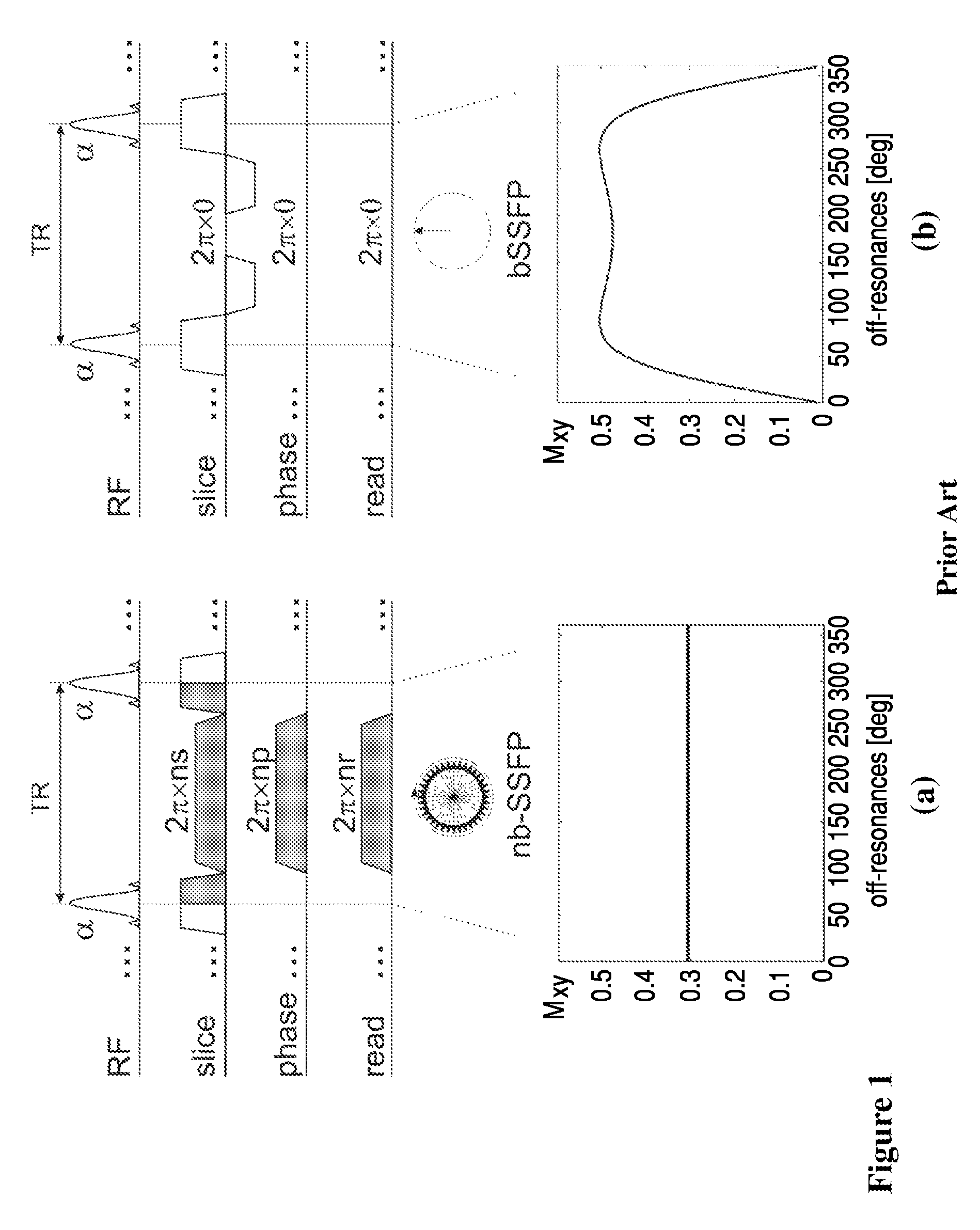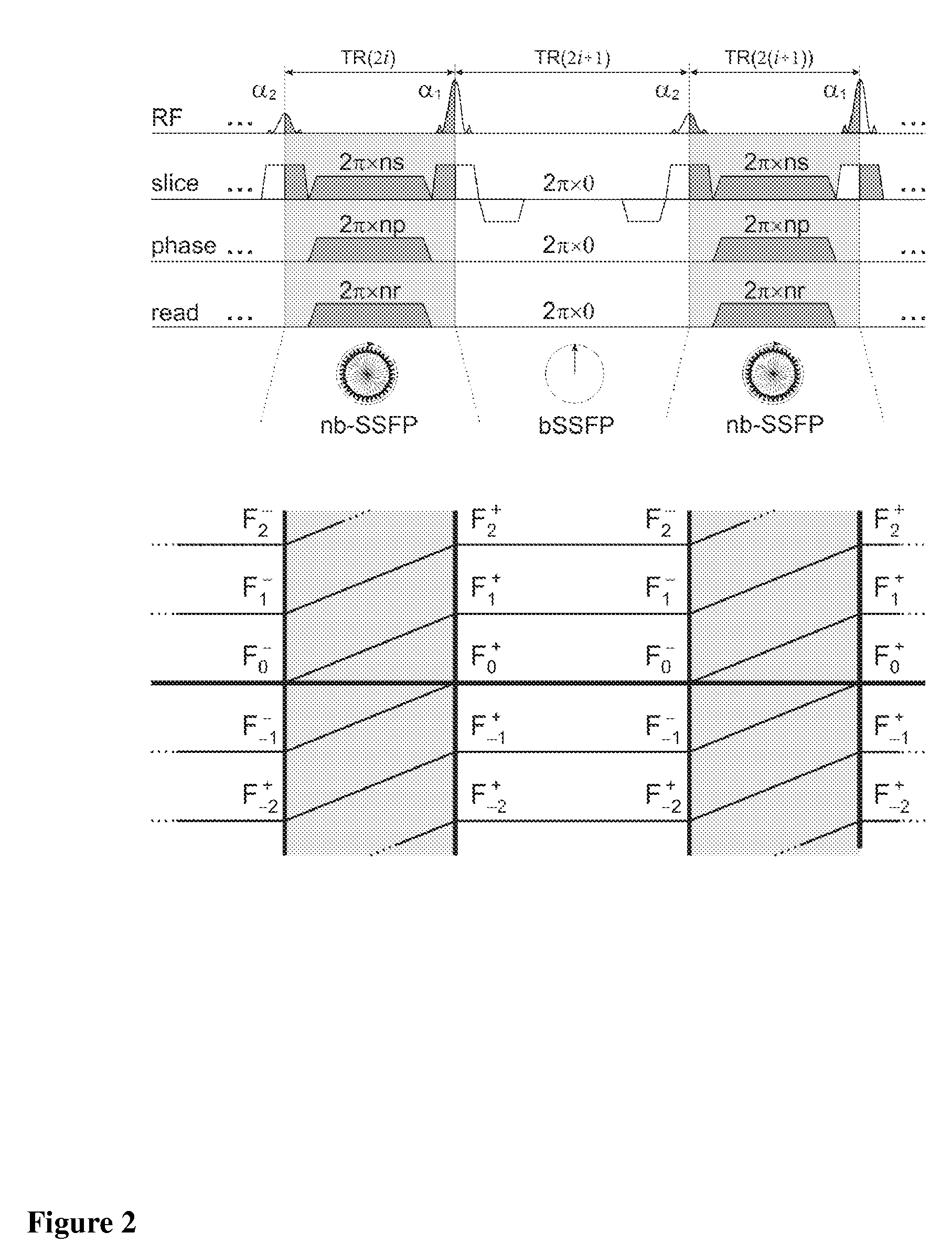Modification of frequency response profiles of steady state free precession for magnetic resonance imaging (MRI)
a technology frequency response profile, which is applied in the field of modification of frequency response profile of steady-state free precession for magnetic resonance imaging (mri), can solve problems such as motion-related image artifacts and suffer from off-resonance related signal modulations
- Summary
- Abstract
- Description
- Claims
- Application Information
AI Technical Summary
Benefits of technology
Problems solved by technology
Method used
Image
Examples
example 1
Functional MRI
[0051]Using the embodiment of the invention as presented in FIG. 3a, neuronal activity can be mapped generating a functional image contrast (fMRI). Here, the Chimera SSFP makes use of the frequency related shift, identical with the well-known existing frequency sensitive fMRI acquisition techniques based on SSFP (Scheffler, 2001; Miller, 2003). Since non-balanced SSFP is moderately sensitive to flow or motion, dephasing moments within TR2 were flow compensated (to TR). FMRI data was acquired with a standard block design (20 s / 20 s on / off) using a visual stimulus (checkerboard). Pixels in the visual cortex that showed a correlation coefficient >0.3 (FIG. 8(a)) were classified as being active and corresponding average signal time courses (FIG. 8(b)). FMRI Chimera sequence parameters were: TR1=3 ms, TR2=6 ms, α1=α2=20°, using two scans with phase offset of ±90° from on-resonance. The time resolution of the Chimera fMRI scan was 1 sec using a slice thickness of 5 mm and a ...
example ii
[0052]Similarly, temperature changes can be mapped using an embodiment analogous to FIG. 3a: A test tube filled with a viscous aqueous solution (with relaxation times T1˜1 s, T2˜40 ms) was equilibrated at −5° C. The image shown in FIG. 9a shows a Chimera SSFP scan immediately after mounting the test tube into a spherical holder (essentially containing the same solution and equilibrated in the scanner at a room temperature of 20° C.). The temperature in the surrounding of the test tube is thus elevated by 15°. Temperature scans were acquired using TR1=8 ms, TR2=8 ms, α1=α2=20° with a temporal resolution of 1 sec / scan. At 1.5 T, a frequency shift of 0.01 ppm / ° C. yields approximately 0.23° / ms phase advance. This corresponds to a phase advance of about 28° / TR (TR1=8 ms). As a result, an initial signal difference (ΔS) of about ΔS=100%·(28 / 180)=15% can be expected. This is in good agreement with measurements (FIG. 9b).
example iii
CSI
[0053]Imaging of different resonance frequencies of metabolites can be achieved using the embodiment of the invention as presented in FIG. 4a or 4b. In this case the echo signal acquired during the readout gradient is the complex sum of all resonance frequencies or metabolites present in the sample, weighted with their corresponding Chimera SSFP frequency profile. To produce chemical shift selective images of each resonance of the metabolites for known resonance frequencies, in a preferred implementation, the acquisition can be carried out such that acquisition is repeated in several steps such that in each individual acquisition each signal is differently weighted by the Chimera SSFP frequency profile. Different weighting is achieved by using different linear phase increments φ of the excitation pulses for each individual acquisition such that the resulting frequency profile is shifted in frequency direction by a certain amount. For each individual acquisition the measured echo ...
PUM
 Login to View More
Login to View More Abstract
Description
Claims
Application Information
 Login to View More
Login to View More - R&D
- Intellectual Property
- Life Sciences
- Materials
- Tech Scout
- Unparalleled Data Quality
- Higher Quality Content
- 60% Fewer Hallucinations
Browse by: Latest US Patents, China's latest patents, Technical Efficacy Thesaurus, Application Domain, Technology Topic, Popular Technical Reports.
© 2025 PatSnap. All rights reserved.Legal|Privacy policy|Modern Slavery Act Transparency Statement|Sitemap|About US| Contact US: help@patsnap.com



